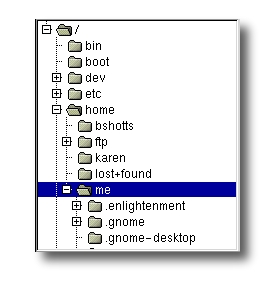Navigation
In this lesson, we will introduce our first three commands: pwd (print working
directory), cd
(change directory), and ls (list files and directories).
Those new to the command line will need to pay close attention to this lesson since the concepts will take some getting used to.
File System Organization
Like Windows, the files on a Linux system are arranged in what is called a hierarchical directory structure. This means that they are organized in a tree-like pattern of directories (called folders in other systems), which may contain files and subdirectories. The first directory in the file system is called the root directory. The root directory contains files and subdirectories, which contain more files and subdirectories and so on and so on.
Most graphical environments include a file manager program used to view and
manipulate the contents of the file system. Often we will see the file system
represented like this:

One important difference between Windows and Unix-like operating systems such as Linux is that Linux does not employ the concept of drive letters. While Windows drive letters split the file system into a series of different trees (one for each device), Linux always has a single tree. Different storage devices may be different branches of the tree, but there is always just a single tree.
pwd
Since the command line interface cannot provide graphic pictures of the file system structure, we must have a different way of representing it. To do this, think of the file system tree as a maze, and that we are standing in it. At any given moment, we are located in a single directory. Inside that directory, we can see its files and the pathway to its parent directory and the pathways to the subdirectories of the directory in which we are standing.
The directory we are standing in is called the working directory. To
see the name of the working directory, we use the pwd
command.
pwd
/home/meWhen we first log on to our Linux system, the working directory is set to our home directory. This is where we put our files. On most systems, the home directory will be called /home/user_name, but it can be anything according to the whims of the system administrator.
To list the files in the working directory, we use the ls command.
ls
Desktop Downloads foo.txt Pictures Templates
Documents examples.desktop Music Public VideosWe will come back to ls in the next lesson. There
are a lot of fun things you can do with it, but we have to talk about pathnames
and directories a bit first.
cd
To change the working directory (where we are standing in the maze) we use
the cd command. To do this, we type cd followed by the pathname of the desired working
directory. A pathname is the route we take along the branches of the tree to
get to the directory we want. Pathnames can be specified two different ways;
absolute pathnames or relative pathnames. Let's look with
absolute pathnames first.
An absolute pathname begins with the root directory and follows the tree
branch by branch until the path to the desired directory or file is completed.
For example, there is a directory on your system in which most programs are
installed. The pathname of the directory is /usr/bin. This means
from the root directory (represented by the leading slash in the pathname)
there is a directory called "usr" which contains a directory called "bin".
Let's try this out:
cd /usr/bin
me@linuxbox bin]$ pwd
/usr/bin
me@linuxbox bin]$ ls
'[' mshortname
2to3-2.7 mshowfat
411toppm mtools
a2ps mtoolstest
a2ps-lpr-wrapper mtr
aa-enabled mtrace
aa-exec mtr-packet
aclocal mtvtoppm
aclocal-1.15 mtype
aconnect mutter
acpi_listen mxtar
add-apt-repository mzip
addpart namei
and many more...Now we can see that we have changed the current working directory to
/usr/bin and that it is full of files. Notice how the shell prompt
has changed? As a convenience, it is usually set up to display the name of the
working directory.
Where an absolute pathname starts from the root directory and leads to its destination, a relative pathname starts from the working directory. To do this, it uses a couple of special notations to represent relative positions in the file system tree. These special notations are "." (dot) and ".." (dot dot).
The "." notation refers to the working directory itself and the ".." notation refers to the working directory's parent directory. Here is how it works. Let's change the working directory to /usr/bin again:
cd /usr/bin
me@linuxbox bin]$ pwd
/usr/binO.K., now let's say that we wanted to change the working directory to the
parent of /usr/bin which is /usr. We could do that
two different ways. First, with an absolute pathname:
cd /usr
me@linuxbox usr]$ pwd
/usrOr, with a relative pathname:
cd ..
me@linuxbox usr]$ pwd
/usrTwo different methods with identical results. Which one should we use? The one that requires the least typing!
Likewise, we can change the working directory from /usr to
/usr/bin in two different ways. First using an absolute
pathname:
cd /usr/bin
me@linuxbox bin]$ pwd
/usr/binOr, with a relative pathname:
cd ./bin
me@linuxbox bin]$ pwd
/usr/binNow, there is something important that we must point out here. In most cases, we can omit the "./". It is implied. Typing:
cd binwould do the same thing. In general, if we do not specify a pathname to something, the working directory will be assumed. There is one important exception to this, but we won't get to that for a while.
A Few Shortcuts
If we type cd followed by nothing, cd will change the working directory to our home
directory.
A related shortcut is to type cd
~user_name. In this case, cd will
change the working directory to the home directory of the specified user.
Typing cd - changes the working
directory to the previous one.